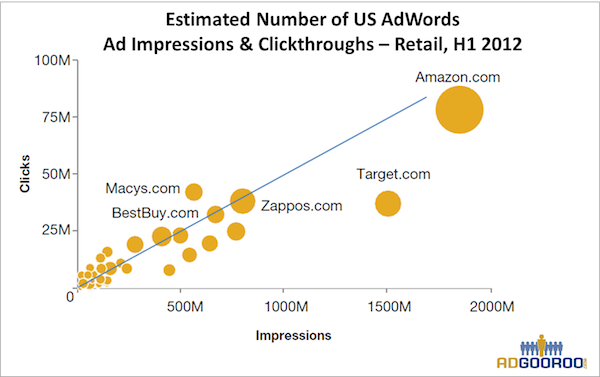If you’re spending money on search engine marketing to drive retail sales, chances are you’ve asked yourself, “how do I measure up against Amazon?” and “can I even compete with Amazon?”
Indeed, new research by AdGooroo (full disclosure: I’m an employee) finds that Amazon is in a class by itself when it comes to attracting site visitors via its SEM practices. By our estimate, the company spends nearly twice as much on Google AdWords per month than the next largest retail PPC spender.
Moreover, Amazon is not only Google’s biggest customer, but extremely successful at gaining first SERP impressions. For example, Amazon received first SERP impressions on U.S. AdWords for more than 230,000 keywords in February, 2012, and for more than 650,000 distinct searched keywords over the past 12 months.

The size of Amazon’s keyword “success set” demonstrates the power of its SEM machine compared to that of other retailers during the same period:
- Amazon’s success set was 48 percent larger than Target’s, the next ‘busiest’ retail PPC marketer during that period in volume of sponsored keywords, impressions, spend and clicks
- Two times larger than Wal-Mart’s success set
- 7.6 times larger than Macy’s and
- 8.6 times larger than JC Penney’s
Yet, this top-down view doesn’t tell the whole story.
When examining three verticals outside of Amazon’s traditional sweet spot of books, music and other media, for instance, AdGooroo found that many retailers who were not only competitive in their PPC campaigns but actually giving Amazon a run for its money. Below are findings for each of the three verticals.
Children’s Products
Amazon sponsored more of the highest PPC spend keywords in the Children’s Products category than any other retailer (12.7 percent), but was outperformed by a number of advertisers that had the advantage of strong brand recognition.
American Girl, Lego, Hasbro, Toys “R” Us and Children’s Place all garnered more desirable ad positioning as well as a much larger share of impressions on their chosen category keywords: Children’s Place – 81 percent; American Girl – 69 percent; Lego – 68 percent; Toys“R”Us – 50 percent compared to Amazon’s 31 percent.
Even Target, whose offering and SEM strategy resemble Amazon’s more than the aforementioned children-centric brands, garnered impressions on 52 percent of the searches performed on the keywords which it chose to sponsor in the category.
Fashion & Apparel
Amazon also led in the percentage of top PPC spend keywords sponsored in the Fashion & Apparel category (13.9 percent), but, again, its competitors reaped more favorable results.
The top five PPC advertisers in the category based on ad position—Express, Victoria’s Secret, Bloomingdales, 6pm.com and Loft.com—each netted more than 3 times as many impressions per category KW per day as Amazon.
Further, Amazon had the lowest ad coverage, the second lowest click-through rate, and the third highest cost-per-click. Although it trailed the pack in terms of average ad position, Target recorded higher click-through rates and a larger share of impressions than Amazon on the category keywords that it sponsored.
Auto Parts
Although not traditionally thought of as a provider of automobile parts and accessories, Amazon is most definitely a competitor in the Auto Parts paid search category, as shown by its broad set of sponsored keywords, which was second only to AutoZone’s KW set.
However, Amazon’s paid search performance trailed that of its competitors, generating the highest CPC, the lowest average position and only a 13 percent share of impressions on the keywords that it chose to sponsor.
AutoZone, O’Reilly Auto Parts and even Target appeared to be competing less with Amazon than with each other.
How Does One Compete With Amazon?
So what lessons are to be learned from these findings?
First, don’t get cocky. The research outlined above was based on a mere snapshot in time for a company that takes the long view (watch Jeff Bezos’ explanation of the Zappos acquisition on YouTube). A year from now, don’t be surprised to find that Amazon has improved its PPC performance in each of these categories.
In addition, Amazon has a brilliant business model with real competitive advantages. For instance, the company collects and leverages millions of data points on visitors’ product searches, consideration, preferences, wish-lists and actual purchases to fuel a truly exceptional CRM engine and maximize the value of each visitor’s checkout via tailored product suggestions. So, retail competitors must leverage their own business model and merchandising strengths that distinguish them from the online giant.
Amazon may have already won the battle in books, music, and content media, but in other retail categories, well-established retailers with strong brands are not only holding their own but, depending upon which KPI’s one chooses to define success, are actually beating Amazon handily in paid search.
Another way to look at it: by choosing to compete in so many categories simultaneously, Amazon is vulnerable to being out-marketed by specialty retailers and out-flanked by clever and nimble paid search practitioners.
Smart SEMs should keep their campaigns fresh and topical and look to offer AdWords a competitive level of revenue per search impression.
They should also utilize competitive PPC intelligence to monitor the paid search activities of Amazon and others in the category. Indeed, given the highly competitive nature of paid search, it is critical that marketers know as much as possible about what their competition is doing online.
For example, a search marketer can identify the weaker keywords in its success set and decide whether to pull back on bids on those keywords, or focus efforts on improving ad copy and landing page relevance to fight back.
Of course, there are lots of ways that search marketers can refine their campaigns to compete more ably against Amazon, or any SEM in their category, but that will have to be the stuff of future columns.
